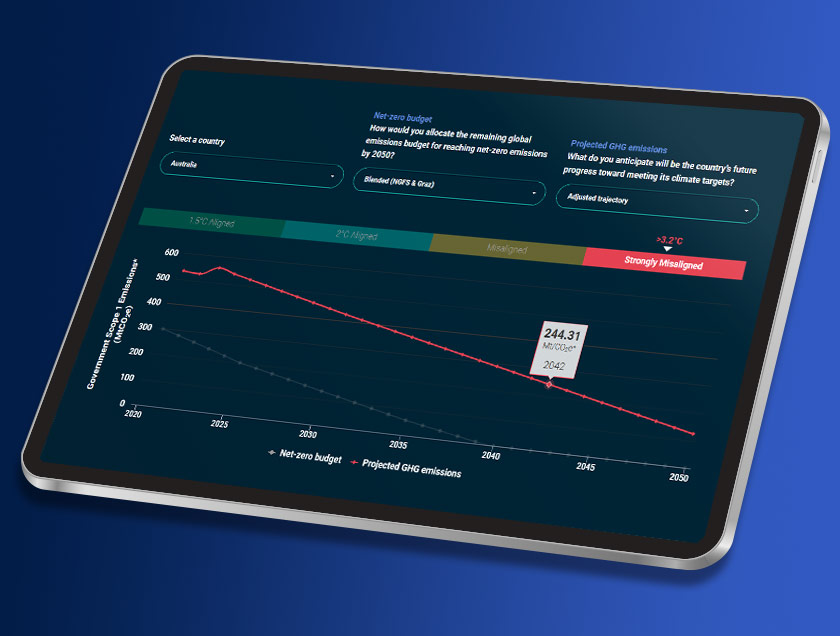U.S.-listed companies lag their peers globally in disclosing their financially relevant climate risks.
Nearly three-quarters (73%) of listed companies in developed markets outside the U.S. reported their direct (Scope 1) and indirect (Scope 2) greenhouse gas (GHG) emissions, the latest data from MSCI ESG Research shows.[1] In comparison, 45% of U.S-listed companies reported their Scope 1 and Scope 2 emissions as of the same date.
While reporting of value chain (Scope 3) emissions continues to be a topic of contention, more than half (54%) of listed companies in developed markets outside the U.S. report at least some of their Scope 3 emissions, compared with 29% of U.S.-listed firms.
U.S.-listed companies lag listed firms in other developed markets in disclosing their greenhouse gas emissions
While reporting of value chain (Scope 3) emissions continues to be a topic of contention, more than half (54%) of listed companies in developed markets outside the U.S. report at least some of their Scope 3 emissions, compared with 29% of U.S.-listed firms.
Source: MSCI ESG Research, February 15th, 2024
A growing transparency gap
In the three years ending 2021, the most recent for which emissions reporting by the lion’s share of listed companies is available, the number of U.S.-listed companies reporting their Scope 1, 2 and any Scope 3 emissions has increased by 5 percentage points. Meanwhile, listed companies in developed markets outside the U.S. increased their reporting by 10 percentage points over the same period.
Source: MSCI ESG Research, February 15th, 2024
The gap goes beyond reporting emissions. Eighteen percent of U.S.-listed firms have pledged to reduce their emissions in line with the global goal of limiting global warming this century to 1.5 °C (2.7°F) above preindustrial levels, the threshold for preventing the costliest warming. Nearly one-third (31%) of listed firms in other developed economies have committed to cut their carbon footprint in line with that aim.
Fewer U.S.-listed companies have set science-based climate targets
Eighteen percent of U.S.-listed firms have pledged to reduce their emissions in line with the global goal of limiting global warming this century to 1.5 °C (2.7°F) above preindustrial levels, the threshold for preventing the costliest warming. Nearly one-third (31%) of listed firms in other developed economies have committed to cut their carbon footprint in line with that aim.
Source: MSCI ESG Research, February 15th, 2024.
This transparency gap hinders the ability of investors who regard climate risk as financially relevant to price U.S. companies accurately. The gap is also growing. In the three years ending 2021, the most recent for which emissions reporting by the lion’s share of listed companies is available, the number of U.S.-listed companies reporting their Scope 1, 2 and any Scope 3 emissions has increased by 5 percentage points.[2] Meanwhile, listed companies in developed markets outside the U.S. increased their reporting by 10 percentage points over the same period.
Demand from near and far
Investors, banks and insurers, meanwhile, are increasingly factoring the financial risks of climate change into their decisions. They are demanding more, not less, climate-related financial information from listed and unlisted companies alike. As one large investment manager noted at the launch of our Institute last year, “if we don’t know the emissions, we don’t know the climate risk involved.”
Climate risk also affects every asset. Warren Buffett complains in his latest annual letter to shareholders that “climate change adds to” the worries of investors in Berkshire Hathaway’s utility subsidiary, which faces an uncertain outlook triggered by catastrophic weather events in the western states.
The U.S. represents about 15% of the world’s gross domestic product, but U.S.-listed companies constitute roughly 45% of the total value of global equity markets, two-and-a-half times the value of their counterparts in the EU and China combined.[3]
Despite the dominance of U.S.-listed companies in the market, mandating disclosure of climate-related risks may come from elsewhere. Starting this year, the European Union’s Corporate Sustainability Reporting Directive (CSRD) will require companies, including non-EU firms with subsidiaries or sufficiently large businesses in the bloc, to publish their financially relevant GHG emissions across all three scopes and report on whether their carbon targets align with science-based criteria. Several thousand U.S. companies could be covered by the EU requirement.[4]
Whether compelled by investors or commanded by regulation, disclosures of GHG emissions, especially Scope 3 emissions in the value chain, can present challenges for companies given the present reliance on estimation models. But companies are learning by doing. Among U.S.-listed companies in the carbon-intensive utilities, materials and energy sectors, for example, 66%, 46% and 29% of companies, respectively, reported at least some of their Scope 3 emissions, as of Feb. 15, 2024.[5] The prospect of mandatory disclosure is also spurring innovations in carbon accounting that could in time improve both the ease and accuracy of emissions reporting.[6]
Reporting of GHG emissions by U.S.-listed companies in 11 sectors
Whether compelled by investors or commanded by regulation, disclosures of GHG emissions, especially Scope 3 emissions in the value chain, can present challenges for companies given the present reliance on estimation models. But companies are learning by doing. Among U.S.-listed companies in the carbon-intensive utilities, materials and energy sectors, for example, 66%, 46% and 29% of companies, respectively, reported at least some of their Scope 3 emissions, as of Feb. 15, 2024.
Source: MSCI ESG Research, February 15th, 2024.
Still, the fact that climate disclosures of U.S.-listed companies are failing to keep pace with global peers means that investors are increasingly left to manage around a massive blind spot of financial risk they can neither know or measure. It leaves investors to lean into assumptions that may inadvertently penalize companies by overestimating their carbon exposure or underestimating their progress in reducing climate risk.
Managing the uncertainties of climate risk will require a race to the top when it comes to corporate disclosure. Investors need information.
I would like to thank my colleague Kenji Watanabe for his contributions to this blog post.
[1] Companies represented by the MSCI ACWI USA Investable Market Index and MSCI World Investable Market Index, respectively.
[2] Reporting of greenhouse gas emissions by listed companies lags the current year because companies publish their emissions in the year following the financial year in which they tally them. Some companies whose 2022 financial years ended in 2023 have yet to publish their 2022 emissions.
[3] See “World Economic Outlook,” International Monetary Fund, October 2023, and “Research Quarterly: Equities,” Securities Industry and Financial Markets Association, Jan. 25, 2024
[4] MSCI ESG Research, data as of Feb. 29, 2024
[5] MSCI ESG Research data based on GICS® industry sectors. GICS® refers to the global industry classification standard jointly developed by MSCI Inc. and S&P Global Market Intelligence. The GICS® structure comprises 11 sectors, 24 industry groups, 69 industries and 158 sub-industries.
[6] See, e.g., “Getting a Clearer View of Your Company’s Carbon Footprint,” Robert S. Kaplan, Karthik Ramanna, and Stefan J. Reichelstein, Harvard Business Review, April 3, 2023


